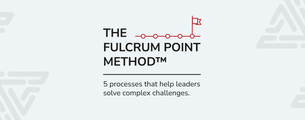Complex environments demand clarity. The Fulcrum Point Method™ identifies the most strategic leverage point so organizations can act with focus and precision.
Here are the challenges where the Fulcrum Point Method™ delivers the most impact — with real-world scenarios executives can relate to:
Getting Stakeholder Buy-In
- The challenge: Without alignment, operational and cultural change efforts stall and waste resources.
- Example: A leadership team needed to modernize internal operations, but every department had a different view of what “modernization” meant. By applying the Fulcrum Point Method™, the organization aligned around a single direction, reducing resistance and turning a culture clash into unified momentum.
Choosing the Right Action
- The challenge: Leaders face many possible moves but can’t tell which one will unlock support, funding, or momentum.
- Example: An operations leader saw dozens of possible ways to cut costs and improve efficiency. Instead of launching multiple disconnected projects, the Fulcrum Point Method™ identified one high-leverage change that delivered immediate savings and freed up hours of staff time per day.
Adapting the Narrative
- The challenge: In fast-moving environments, a rigid story erodes credibility and stakeholder confidence. Many projects require ongoing narrative monitoring and rapid pivots.
- Example: An organization balancing tradition with the need to modernize found itself stuck in conflicting narratives. The Fulcrum Point Method™ clarified the core message and created room to adapt quickly, so leaders could respond to shifting pressures without losing coherence or authority.
Overcoming Approval Barriers
- The challenge: Disorganized initiatives often stall when approval is needed from internal and/or external stakeholder, costing time and opportunities.
- Example: A promising initiative was delayed because decision-makers didn’t see a clear sequence of steps or a well-structured case for approval. By restructuring the effort around the Fulcrum Point™, we ensured that both internal executives and external regulators gave the green light, unlocking opportunities and funding.
Managing Complex Stakeholders
- The challenge: Too many stakeholders with competing priorities create paralysis and wasted effort.
- Example: An organization pursuing external funding was pulled in different directions by advisors, internal teams, and external stakeholders. The Fulcrum Point Method™ clarified which priorities mattered most for success, allowing leadership to focus resources where they actually produced results instead of trying to satisfy everyone at once.
Bottom Line
Complexity doesn’t have to mean confusion. By applying the Fulcrum Point Method™, organizations replace scattered efforts with decisive action. That means faster results, less wasted spend, reduced risk, and measurable outcomes leaders can confidently take to their board, investors, and stakeholders.
Downloads
Supplemental Resources
Problems the Fulcrum Point Method™ Solves.pdf
Complex environments demand clarity. Learn the challenges where the Fulcrum Point Method™ delivers the most impact.





